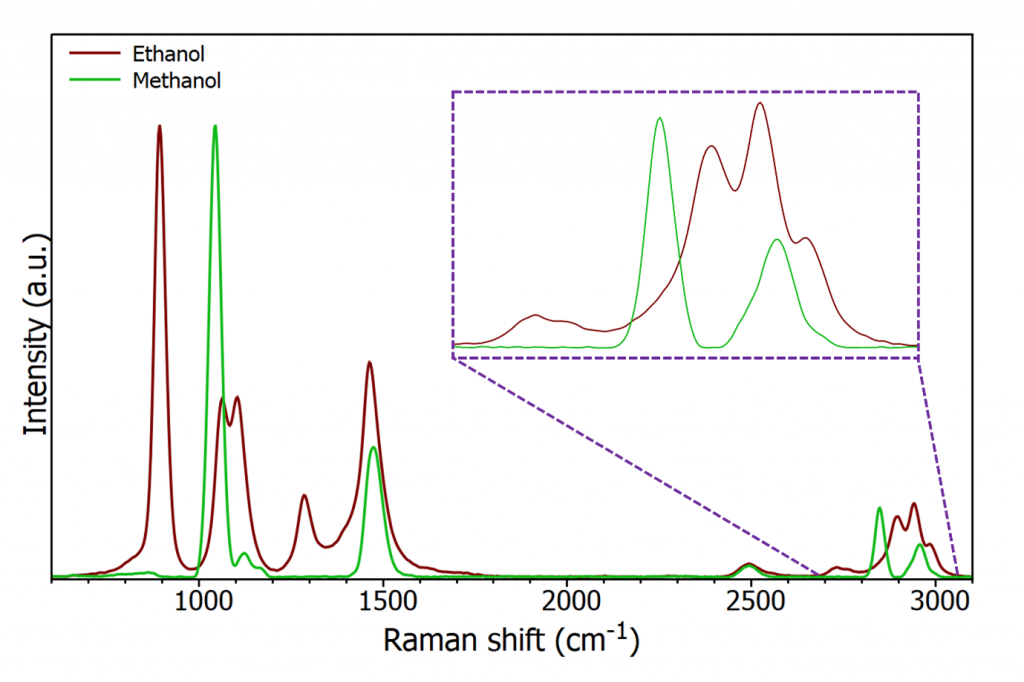Food Analysis and Raman Spectroscopy
Food Analysis is increasingly important to tackle food fraud and ensure food security.
Our Applications Scientist Angela Flack was recently interviewed by Chemical and Engineering News to feature in an article about how analytical chemistry can help aid the battle against food and drinks adulteration. Raman spectroscopy was highlighted due to its powerful identification and discrimination abilities, whilst also offering a non-destructive technique keeping samples intact. In this blog post we highlight Raman spectroscopy’s skill at keeping your shopping basket safe, from methanol identification in drinking alcohol to identifying fraudulent edible oils during food analysis.
Food Analysis Examples
Whisky analysis
One of the major issues seen in the alcohol industry is the production and sale of dangerous alcohol. Vendors may seek to cut costs by diluting their alcohol products with water, or worse, by adding methanol. Methanol is a chemical molecularly similar to ethanol, differing only by 1 carbon and 2 hydrogen atoms. However, the two molecules behave significantly differently in the human body.
Figure 1: Methanol and ethanol’s chemical structure
Whilst ethanol is found in all drinking alcohol, methanol is highly dangerous to human health. Ethanol is metabolised in the liver by alcohol dehydrogenase enzymes, eventually being broken down to harmless carbon dioxide and water. Methanol meanwhile is toxic to humans; it’s commonly found in antifreeze. After consuming methanol, the alcohol dehydrogenase enzyme converts the methanol into formaldehyde which is then rapidly metabolised into formic acid. The potential effects from methanol poisoning range from, but are not limited to, central nervous system depression, nausea, blindness, coma, and death.
It’s vitally important to easily and rapidly identify the presence of methanol in drinking alcohol. Raman spectroscopy is an ideal technique for this. The sample can be checked without any risk of damage and produces an obvious additional peak when methanol is present, Figure 2.
Figure 2: Raman spectrum of ethanol and methanol (insert is expanded high wave number region).
Two bands are generally used to identify the presence of methanol, one at approx. 1035 cm-1 and another at approx. 2845 cm-1. Such spectra are measured in less than one second providing simple and rapid methanol identification.
Oil Adulteration
Whilst it might appear less sinister than methanol poisoning, another food fraud frequently seen is with edible oils. At the supermarket we are used to seeing the oil selection labelled with the likes of grapeseed oil, olive oil, extra virgin olive oil (EVOO) etc, and the price is meant to represent the quality. However, one issue found is cheaper oils being sold at a higher price than its true quality. One example is EVOO being mixed with cheaper oils but still being sold as a higher quality product, with the price tag to match.
In this case subtle differences in the Raman spectra from different oils can be used for adulteration identification by utilising the multivariate analysis technique of hierarchal cluster analysis (HCA). Spectra from olive oil, grapeseed oil, EVOO, and mixtures of the cheaper oils in EVOO were measured and HCA carried out. HCA works by determining the samples which are the most spectrally similar and working up the dendrogram until there is only one class.
 Figure 3: HCA of EVOO, olive oil, grapeseed oil, and two adulterated EVOO samples
Figure 3: HCA of EVOO, olive oil, grapeseed oil, and two adulterated EVOO samples
HCA produces distinct clusters between the oil samples, easily identifying the adulterated samples whilst also distinguishing between the two adulterated samples. Starting at the top of the dendrogram (right hand side of Figure 3) the first two clusters separate the samples into those containing grapeseed oil and the samples containing EVOO and olive oil. The addition of grapeseed oil to EVOO alters the spectrum such that the resulting sample is more similar in nature to grapeseed oil than EVOO meaning we get a cluster containing grapeseed oil, and grapeseed oil + EVOO. HCA then further separates that cluster into two allowing the identification of the adulterated EVOO sample. Using this approach samples which are even more similar, e.g., olive oil and EVOO can also be separated from each other, as well successfully identifying the presence of a mixture.
Conclusion
Raman spectroscopy is a robust, reliable, and rapid method for chemical identification during food analysis. Furthermore, when it comes to the food and drinks market the technique boasts rapid and non-destructive analysis. We’ve briefly touched on some of our application notes on food and drink adulteration, if you want to know more about the topics covered in this blog post you can find the links for the full application notes below.
Keep in Touch
Be the first to find out about our latest product news and applications by following us on social media or signing up to our newsletter using the links below.









